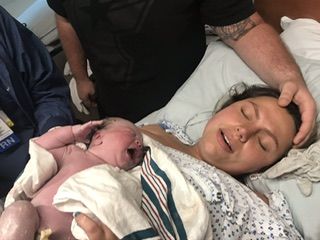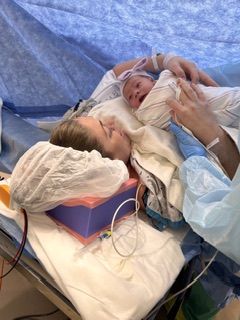This blog will teach you what to expect postpartum. Co-written by our social media coordinator, mom of 3, and L+D nurse, Bri and one of our instructors, soon to be mom of 2, and Pelvic Floor Physical Therapist, Ashley.

What to Expect Postpartum


*This is not medical advice. You should always check with your doctor before attempting any of these methods to make sure it is safe for you.*
What to expect immediately after delivery:
Frequent symptoms you may notice: extreme shaking during and immediately after birth, nausea, contractions (yes, even after birth), fatigue, soreness, lactation changes, lochia (vaginal discharge after giving birth, regardless of delivery method), limited mobility, abdominal changes, edema (swelling), tissue healing, urination changes, bowel changes, trapped gas, emotion/hormone changes, body temperature regulation.
Chewing gum after delivery (particularly a c-section) can be beneficial for promoting early recovery and stimulation of bowel function and digestion!
Everyone recovers differently, but just know these things can happen and there are support people in the world there to help manage them if needed.
If you’re struggling with anything related to bowel, bladder, pelvic or vaginal pain, or challenges with scar healing (vaginal or cesarean) considering reaching out to a Pelvic Floor specialist. You can also see a traditional orthopedic physical therapist if you notice increased low back, wrist, or hip pain during the postpartum period.
Before leaving the hospital: take everything that isn’t linens or reusable (wipes, diapers, A+D, pads, mesh underwear, witch hazel, formula, pump parts, and more). They throw these all away once you leave!
How to prep your home for postpartum:
Things to have at home post delivery:
- Everyone: XL pads and disposable underwear or adult diapers immediately post delivery, overnight pads after a few days/weeks, comfortable underwear, Tylenol, Motrin, colace, prescription pain medication if prescribed by MD
- Vaginal delivery (may need some of these if you pushed and then had a CS): dermaplast, witch hazel, ice packs, peri bottle (can get one in hospital
- C-Section delivery: high waisted underwear, clothes or robes (no tight waist bands), silicone gel tape (for incision healing)
Set house up for success pre-delivery, including bathroom baskets, a pumping cart (if breastfeeding) or bottles and formula station (if formula feeding), baby medication box, and diapering areas for baby.
- Bathroom basket: (one basket for each frequently used bathroom) Pads, underwear, adult diapers, peribottle, ice packs
- Pumping cart: Pump, extra set of pump parts, haakaa, breast pads, nipple cream, milk storage bags, milk syringes, sharpie (to label bags), tissues, snacks, water, medications taken regularly, night light, pacifier and teething toys (if using), diapering supplies (check diaper area list)
- Bottle/formula station: Bottles, nipples, formula of choice, bottle warmer, baby brezza, bottle washer, bottle drying rack
- Baby meds: (make sure all are infant/baby safe before buying) Tylenol, Motrin, simethicone, gripe water, thermometer (forehead and rectal), A+D or Vaseline (for rectal temps), vitamin D, syringes (for med administration), Benadryl, Zyrtec, saline spray, nasal aspirator, nail clippers/electric nail file), bandaids, antibiotic ointment, Active skin repair, baby saline inhaler, portable nebulizer with saline packets, soft ice packs, cool mist humidifier, tweezers, alcohol wipes
- Diaper area: (in all major areas of your house including: baby room, parents room, and where you spend your time during the day, like the living room. Also one for the car). I prefer a caddy for all these areas that don’t have drawers. Changing mat, diapers, wipes, diaper rash cream, baby lotion, burp cloths, swaddle blanket, changes of clothes, stain spray, plastic bags (I like to use doggie bags), hand sanitizer, baby toys.
How to start to promote healing:
Prioritize rest, drink lots of water, eat healthy foods, continuation of prenatal or starting postnatal vitamins, managing pain (take pain medication as needed, do not let pain “catch up” to you as it will be harder to manage later), take a stool softener if needed to ensure daily bowel movements, daily movement (a few times a day starting slow and only a few minutes gradually increasing as long as there is no pain).
Consider using a squatty potty or yoga blocks when going to the bathroom, will help create a better posture and less pain when trying to have a bowel movement while you are healing
Take time for your basic hygiene needs. Showering, brushing teeth and hair, etc will help you feel more like yourself.
Wear comfortable clothing that is not tight. If you had a CS make sure waist bands don’t irritate the incision site.
Ways to start moving before being cleared to workout at 6 weeks:
Short walks: starting around your house then outside. Slowly working up to longer distances and increased pace as you can tolerate.
Stretching and mobility: shoulder rolls (forward and backward), neck rolls (both directions), arm circles (both directions), diaphragmatic breathing, pelvic tilts (start sitting or standing and can move to laying down), cat-cows, baby gates step overs on both sides, ankle and wrist circles (both directions), internal and external rotation of shoulders with hands on hips
Massaging tight muscles: not too deep or intense just enough to relieve stiffness in back, neck, legs, arms, and feet (great for your partner to help)
Pelvic Floor PT: focus on your breathing and reconnecting to your core. (You can start this on first day postpartum) laying down with hands on belly and thinking about slowly drawing abdominal muscles in towards your spine as you exhale (transverse abdominis breathing), be very mindful of abdominal strengthening if you have diastasis recti (abdominal separation) or rib flaring, seeking an evaluation with a pelvic floor therapist they can assess all aspects of your healing and start to progress your recovery process personalized to your needs (pelvic floor strengthening, pelvic floor relaxation, scar massage and mobility, proper deep core isolation and activation, return to running specific training)
Postpartum specific exercises: (work up to this as your body heals, start with stretching and mobility, can use a foam roller especially for hips and upper back) light weights can be added if you decide it works for you, focus on single leg hip strengthening- laying straight leg raises, standing single leg hip hinge, low back strengthening- cat/cow and bird-dogs alternating sides, bear hover holds, bicep curls, tricep dips, squats (lateral side lifts can be added), lunges - forwards, backwards or alternating side lunges, curtsy lunges, sumo squats (shoulder press can be added, heel lifts can be added)
Do not push it, this is a time for your body to rest and recover. Do what feels natural and right for your body. If you do feel ready to move and exercise make sure to add extra water to stay hydrated!
If you notice pain or incontinence as you are returning to exercise, this is something to address as early as possible to prevent further issues later on!
Additional postpartum considerations:
Lactation consultants if you are having issues with any aspects of feeding: breastfeeding, latching, pumping questions or concerns, supply issues, managing clogged ducts or mastitis
Postpartum Mental Health Considerations: postpartum is hard!!! It can be helpful to have your partner aware of symptoms of postpartum depression or anxiety, a lot of times referred to as the baby blues, there are so many resources available and so many doctors who specialize in this field if you feel like you need some guidance/talk therapy or counseling, consider self care, rest, good nutrition, social support (hello FIT4MOM community!!!) support groups, exercise (you can usually ask the hospital you delivered that if they have a monthly support group- Pascack Valley Medical Center, Valley Hospital, Hackensack University, Englewood Hospital, ect).
